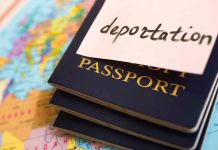
Americans have less than a month to obtain REAL ID-compliant identification before new air travel requirements take effect, potentially leaving unprepared travelers grounded at airports nationwide.
Top Takeaways
- Starting May 7, 2025, all US residents age 18+ must have a REAL ID or acceptable alternative (like a passport) to board domestic flights
- The REAL ID Act was passed in 2005 following 9/11 Commission recommendations to standardize state-issued identification
- REAL ID compliant cards are marked with a star, flag, or the word “Enhanced” in the upper corner
- To obtain a REAL ID, citizens must provide proof of full legal name, date of birth, Social Security number, address, and lawful status
- The compliance deadline has been extended multiple times, but officials insist the May 2025 date is final
National Security Measure Nearly Two Decades in the Making
The REAL ID Act, passed by Congress in 2005 in response to 9/11 Commission recommendations, established minimum security standards for state-issued driver’s licenses and identification cards. The act prevents federal agencies from accepting identification from states that don’t meet these federal security standards. Despite being law for nearly 20 years, full implementation has been repeatedly delayed. The current compliance deadline of May 7, 2025, means Americans have less than a month to ensure they have proper identification or risk being unable to board domestic flights or enter certain federal facilities.
REAL ID-compliant cards are visually distinctive, featuring a star, flag, or the word “Enhanced” in the upper right corner. These markings indicate the ID meets federal standards and has been issued following stricter verification processes. While standard driver’s licenses will remain valid for driving, purchasing age-restricted products, and voting identification in most states, they will no longer be sufficient for boarding domestic flights or entering federal buildings after the deadline.
Real ID deadline is just one month away — here’s what travelers need to know https://t.co/p8SDeC5C3w pic.twitter.com/xUqlxq8WoX
— New York Post (@nypost) April 8, 2025
What You Need to Get REAL ID Compliant
Obtaining a REAL ID requires a visit to your state’s DMV or licensing agency with specific documentation in hand. Applicants must provide proof of their full legal name, date of birth, Social Security number, two proofs of address, and evidence of lawful status in the United States. Documents typically accepted include a birth certificate or passport, Social Security card, and utility bills or bank statements showing residential address. Many states allow residents to pre-verify documents online before visiting in person, potentially streamlining the process.
The Department of Homeland Security recommends not waiting until the last minute to obtain a REAL ID. As the deadline approaches, DMV offices nationwide expect longer wait times and appointment backlogs. Individuals with name changes due to marriage, divorce, or other circumstances may face additional documentation requirements and should plan accordingly. The verification process is notably more stringent than previous ID renewals, reflecting the enhanced security focus of the program.
Alternatives to REAL ID for Air Travel
For those who prefer not to obtain a REAL ID or who may not be able to gather the required documentation in time, several alternatives remain available for domestic air travel. A valid U.S. passport or passport card will continue to be accepted, as will military IDs for service members and their dependents. Enhanced Driver’s Licenses (EDLs) issued by Michigan, Minnesota, New York, Vermont, and Washington are federally approved alternatives to REAL ID and will still be valid for air travel and federal facility access.
For now, travelers can continue using their current state-issued IDs for domestic flights. Mobile Driver’s Licenses (mDLs) will also be accepted by TSA until the May 2025 deadline. The Department of Homeland Security provides an interactive tool on their website where individuals can check if they are “REAL ID ready” and learn about the specific requirements in their state. Despite the approaching deadline, a recent survey indicated only about half of Americans are REAL ID compliant.






















